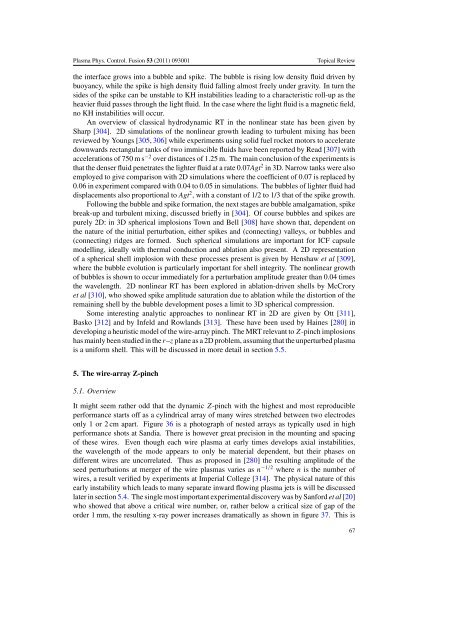You also want an ePaper? Increase the reach of your titles
YUMPU automatically turns print PDFs into web optimized ePapers that Google loves.
Plasma Phys. Control. Fusion 53 (2011) 093001<br />
Topical Review<br />
<strong>the</strong> interface grows into a bubble and spike. The bubble is rising low density fluid driven by<br />
buoyancy, while <strong>the</strong> spike is high density fluid falling almost freely under gravity. In turn <strong>the</strong><br />
sides <strong>of</strong> <strong>the</strong> spike can be unstable to KH instabilities leading to a characteristic roll-up as <strong>the</strong><br />
heavier fluid passes through <strong>the</strong> light fluid. In <strong>the</strong> case where <strong>the</strong> light fluid is a magnetic field,<br />
no KH instabilities will occur.<br />
An overview <strong>of</strong> classical hydrodynamic RT in <strong>the</strong> nonlinear state has been given by<br />
Sharp [304]. 2D simulations <strong>of</strong> <strong>the</strong> nonlinear growth leading to turbulent mixing has been<br />
<strong>review</strong>ed by Youngs [305, 306] while experiments using solid fuel rocket motors to accelerate<br />
downwards rectangular tanks <strong>of</strong> two immiscible fluids have been reported by Read [307] with<br />
accelerations <strong>of</strong> 750 m s −2 over distances <strong>of</strong> 1.25 m. The main conclusion <strong>of</strong> <strong>the</strong> experiments is<br />
that <strong>the</strong> <strong>dense</strong>r fluid penetrates <strong>the</strong> lighter fluid at a rate 0.07Agt 2 in 3D. Narrow tanks were also<br />
employed to give comparison with 2D simulations where <strong>the</strong> coefficient <strong>of</strong> 0.07 is replaced by<br />
0.06 in experiment compared with 0.04 to 0.05 in simulations. The bubbles <strong>of</strong> lighter fluid had<br />
displacements also proportional to Agt 2 , with a constant <strong>of</strong> 1/2 to 1/3 that <strong>of</strong> <strong>the</strong> spike growth.<br />
Following <strong>the</strong> bubble and spike formation, <strong>the</strong> next stages are bubble amalgamation, spike<br />
break-up and turbulent mixing, discussed briefly in [304]. Of course bubbles and spikes are<br />
purely 2D: in 3D spherical implosions Town and Bell [308] have shown that, dependent on<br />
<strong>the</strong> nature <strong>of</strong> <strong>the</strong> initial perturbation, ei<strong>the</strong>r spikes and (connecting) valleys, or bubbles and<br />
(connecting) ridges are formed. Such spherical simulations are important for ICF capsule<br />
modelling, ideally with <strong>the</strong>rmal conduction and ablation also present. A 2D representation<br />
<strong>of</strong> a spherical shell implosion with <strong>the</strong>se processes present is given by Henshaw et al [309],<br />
where <strong>the</strong> bubble evolution is particularly important for shell integrity. The nonlinear growth<br />
<strong>of</strong> bubbles is shown to occur immediately for a perturbation amplitude greater than 0.04 times<br />
<strong>the</strong> wavelength. 2D nonlinear RT has been explored in ablation-driven shells by McCrory<br />
et al [310], who showed spike amplitude saturation due to ablation while <strong>the</strong> distortion <strong>of</strong> <strong>the</strong><br />
remaining shell by <strong>the</strong> bubble development poses a limit to 3D spherical compression.<br />
Some interesting analytic approaches to nonlinear RT in 2D are given by Ott [311],<br />
Basko [312] and by Infeld and Rowlands [313]. These have been used by Haines [280] in<br />
developing a heuristic model <strong>of</strong> <strong>the</strong> wire-array <strong>pinch</strong>. The MRT relevant to Z-<strong>pinch</strong> implosions<br />
has mainly been studied in <strong>the</strong> r–z plane as a 2D problem, assuming that <strong>the</strong> unperturbed plasma<br />
is a uniform shell. This will be discussed in more detail in section 5.5.<br />
5. The wire-array Z-<strong>pinch</strong><br />
5.1. Overview<br />
It might seem ra<strong>the</strong>r odd that <strong>the</strong> dynamic Z-<strong>pinch</strong> with <strong>the</strong> highest and most reproducible<br />
performance starts <strong>of</strong>f as a cylindrical array <strong>of</strong> many wires stretched between two electrodes<br />
only 1 or 2 cm apart. Figure 36 is a photograph <strong>of</strong> nested arrays as typically used in high<br />
performance shots at Sandia. There is however great precision in <strong>the</strong> mounting and spacing<br />
<strong>of</strong> <strong>the</strong>se wires. Even though each wire plasma at early times develops axial instabilities,<br />
<strong>the</strong> wavelength <strong>of</strong> <strong>the</strong> mode appears to only be material dependent, but <strong>the</strong>ir phases on<br />
different wires are uncorrelated. Thus as proposed in [280] <strong>the</strong> resulting amplitude <strong>of</strong> <strong>the</strong><br />
seed perturbations at merger <strong>of</strong> <strong>the</strong> wire plasmas varies as n −1/2 where n is <strong>the</strong> number <strong>of</strong><br />
wires, a result verified by experiments at Imperial College [314]. The physical nature <strong>of</strong> this<br />
early instability which leads to many separate inward flowing plasma jets is will be discussed<br />
later in section 5.4. The single most important experimental discovery was by Sanford et al [20]<br />
who showed that above a critical wire number, or, ra<strong>the</strong>r below a critical size <strong>of</strong> gap <strong>of</strong> <strong>the</strong><br />
order 1 mm, <strong>the</strong> resulting x-ray power increases dramatically as shown in figure 37. This is<br />
67














